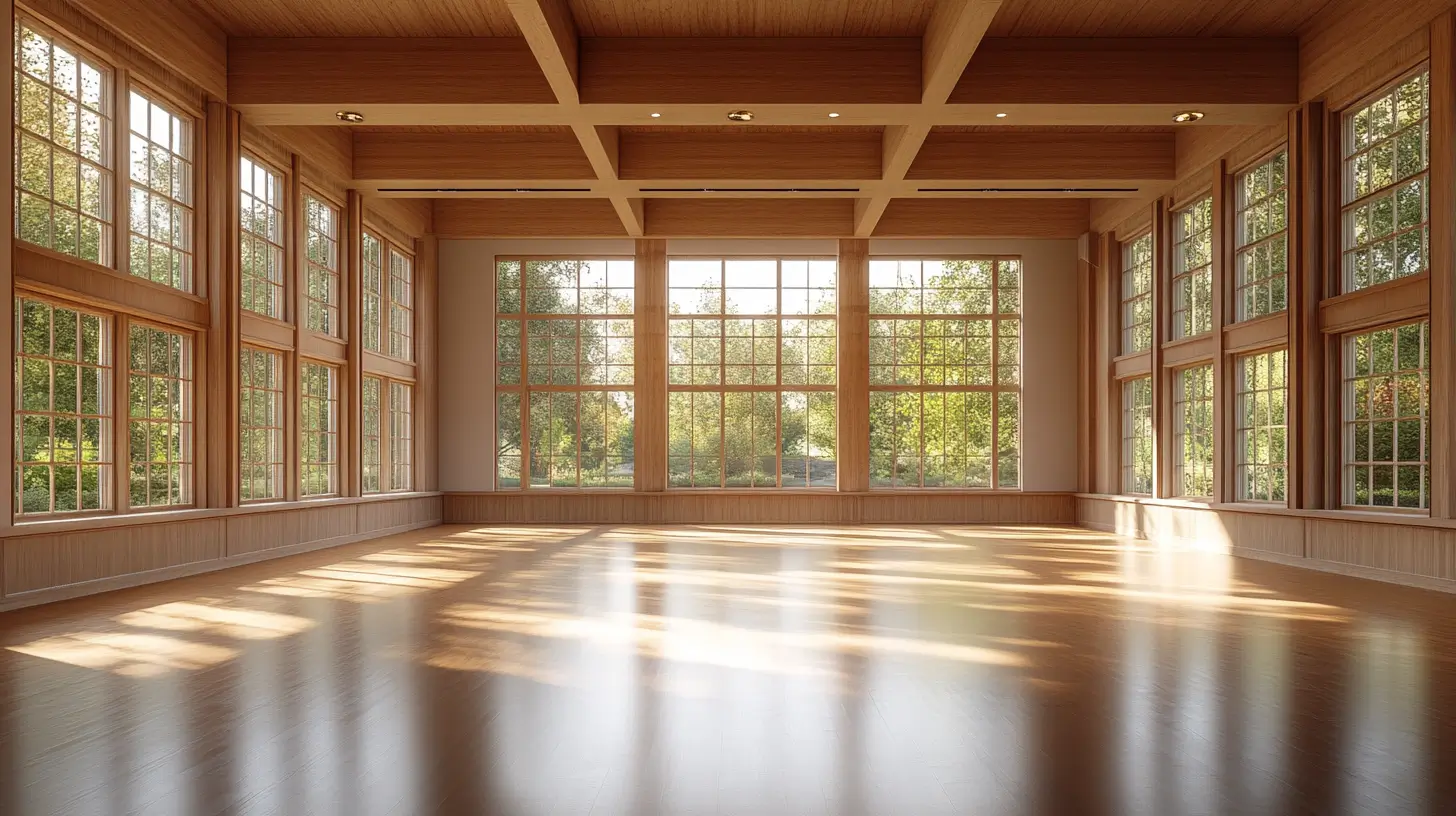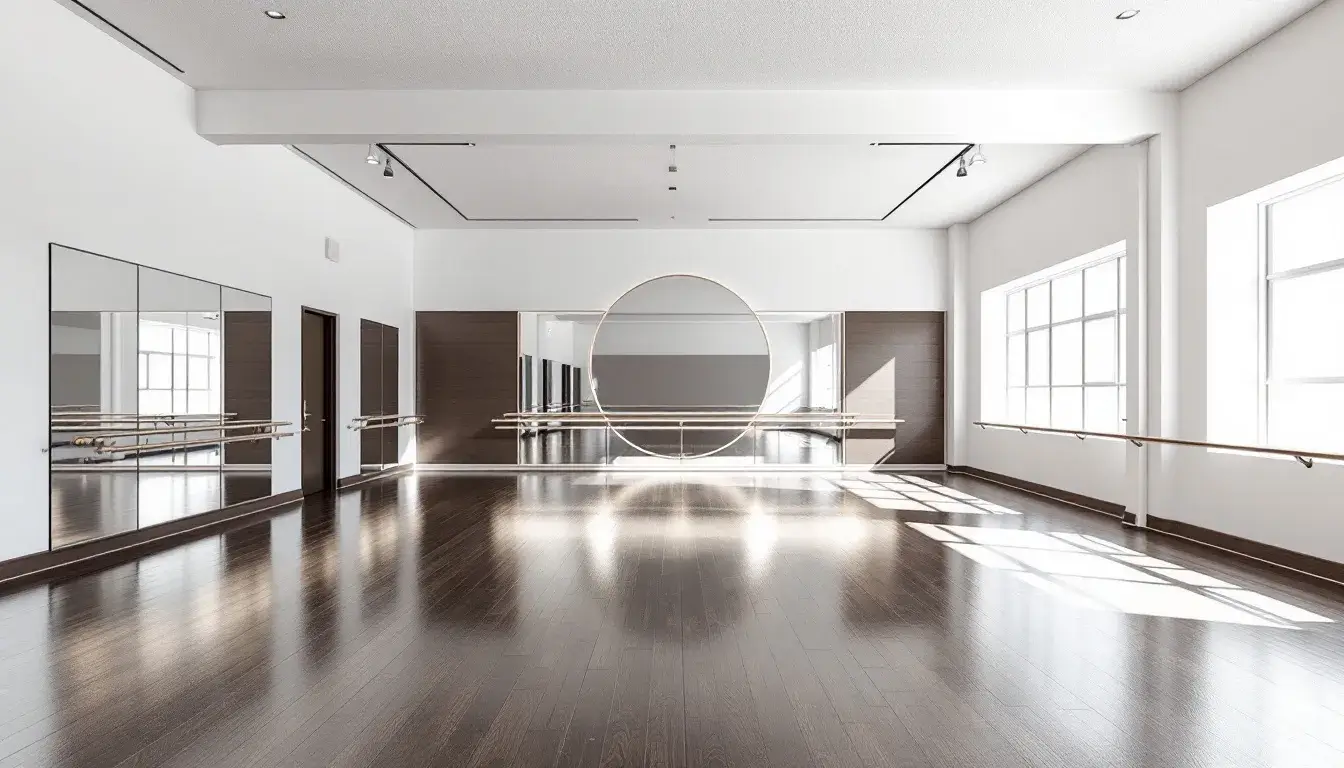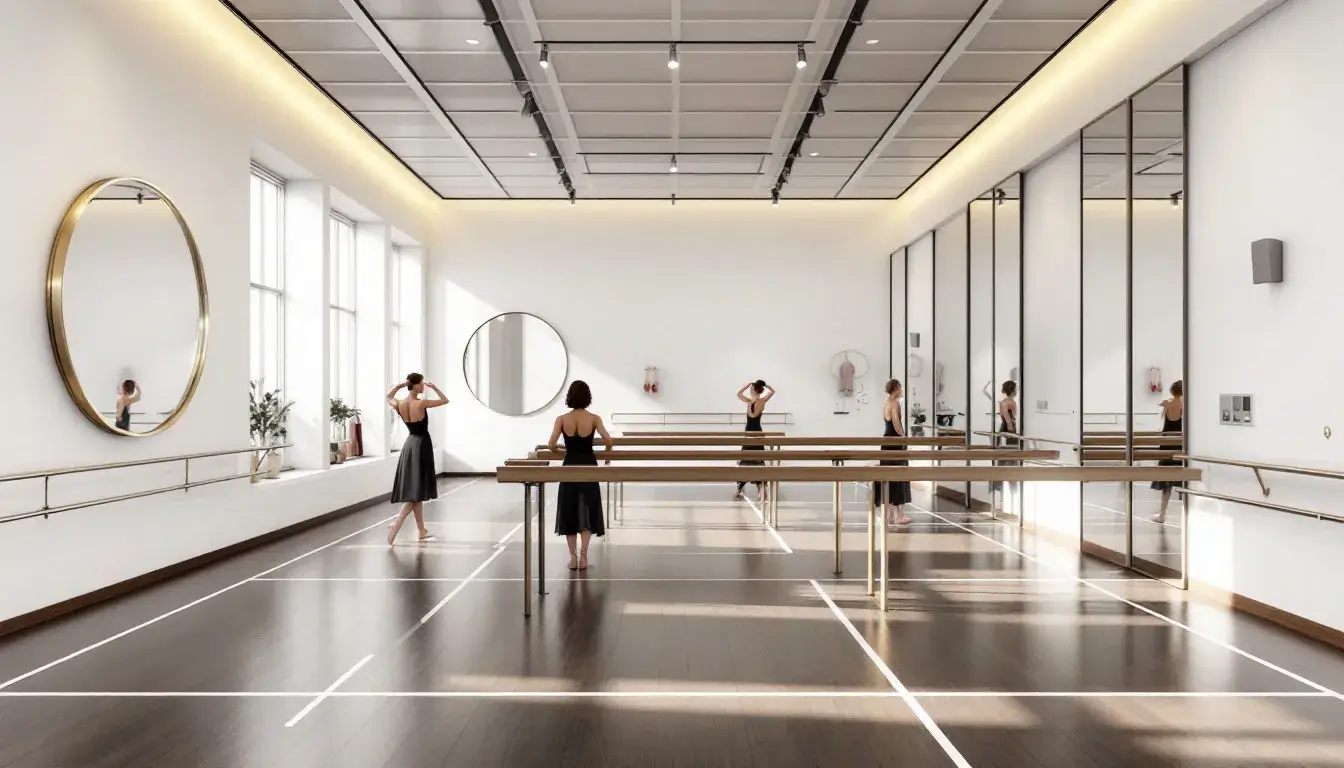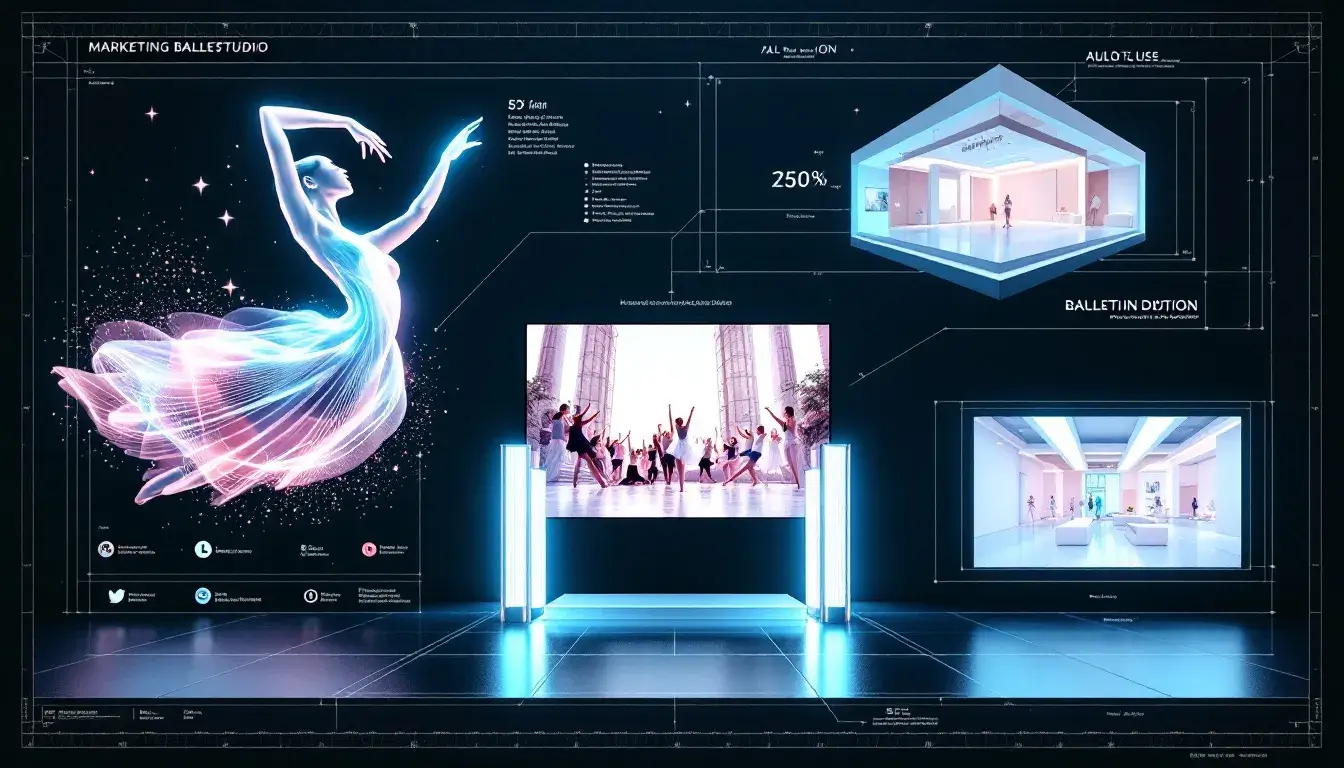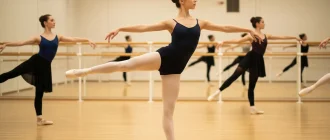Suppose you decide whether to buy or lease commercial real estate for your business, specifically a ballet studio. In that case, this guide covers everything you need to know about commercial real estate for ballet studio options. We’ll discuss space needs, financial planning, and the pros and cons of renting versus buying. Get the insights to make the best choice for your ballet studio.
Graceful Insights
- Understanding specific needs, such as space, location, and amenities, is crucial when selecting a ballet studio property.
- Evaluating financial options between renting and buying a ballet studio involves careful consideration of cash flow, operating expenses, and long-term business goals.
- Effective marketing strategies, strong communication, and relationship-building with students and parents are essential for attracting and retaining clients in a ballet studio.
Art de Podcast
| Aspect | Key Considerations | Impact on a Ballet Studio |
|---|---|---|
| Location | High-visibility, safe, and accessible (near schools/affluent neighborhoods); proximity to public transport and parking | Attracts students, builds community trust, and ensures convenience |
| Property Type & Lease/Purchase | Options for flexible leases versus buying; negotiate favorable renewal terms and repair liabilities | Influences long-term financial commitment and operational flexibility |
| Size & Layout | Adequate square footage (≈100 sq ft per dancer), open floor plan, high ceilings (ideally 20–24 ft) | Provides a safe, spacious environment that meets technical and performance needs |
| Specialized Requirements | Installation of sprung dance floors, large mirrors, fixed ballet barres, proper acoustics, and lighting | Enhances performance quality, reduces injury risk, and supports specific ballet techniques |
| Zoning & Permits | Must meet local zoning for performing arts; obtain business licenses, occupancy, and fire safety permits | Ensures legal compliance and smooth, uninterrupted studio operations |
| Renovation & Build-Out Costs | Costs for specialized flooring, mirror installations, lighting, HVAC, and acoustical treatments | It affects the initial investment and ROI; budgeting for quality build-out is crucial. |
| Parking & Accessibility | Adequate on-site or nearby parking; easy access for students and staff | Increases studio appeal and convenience, particularly for family-oriented clientele |
| Financing Options | Availability of commercial loans, potential down payment requirements, and incentives for small businesses | Determines initial capital outlay and influences long-term financial strategy |
| Market Trends & Competition | Growing demand for boutique, specialized ballet studios; research local competitors and demographic shifts. | Helps position the studio’s brand, tailor pricing, and target marketing efforts |
| Future Growth & Flexibility | Room for expansion or reconfiguration; potential to sublease extra space; adaptable layout options | Supports scalability and long-term strategic growth for adding new programs or services |
Understanding Your Needs
Before entering the real estate market, understanding your ballet studio’s specific needs is crucial. As a dance studio owner, you must consider teaching and management responsibilities during the early stages of establishing your studio. The studio space should be able to accommodate the number of students and the types of classes offered. For instance, younger dancers may require less space, while older dancers need more room to move freely and safely. The types of classes you plan to offer – from beginner ballet to advanced pointe – will determine the overall space required.
The location also significantly impacts the success of your yoga studio. A well-placed studio should be easily accessible, ideally near public transport and offering sufficient parking. The studio layout should include designated areas for check-in, changing rooms, and waiting areas to enhance the experience for students and parents.
High-quality flooring is crucial for dancer safety and performance in yoga studios. It minimizes joint strain and accommodates a variety of dance styles. Effective ventilation and air quality control are also essential, especially during physically demanding classes.
Consider amenities like sound systems, stretching areas, and lockers, which enhance the studio’s appeal and functionality. Planning for potential expansion can prevent costly relocations or modifications later on.
Market Analysis for Dance Studios
Conducting a market analysis is a crucial step in opening a successful dance studio. This involves researching the demand for dance studios in your area, identifying your target audience, and analyzing the competition. Here are some key factors to consider when conducting a market analysis for your dance studio:
- Demand for Dance Studios: Research the local demand for dance studios. Look at the number of dance studios already operating in the area and assess whether there is a need for another studio. Consider population density, demographics, and community interest in dance. This will help you determine if there is sufficient demand to support your new venture.
- Target Audience: Identifying your target audience is essential for tailoring your offerings and marketing strategies. Consider the age, gender, and interests of your prospective students. Are you targeting young children, teenagers, adults, or a mix of all ages? Understanding your audience will help you design classes that meet their needs and preferences.
- Competition: Analyzing the competition in your area is vital for positioning your studio effectively. Look at other dance studios, gyms, and fitness centers that offer dance classes. Evaluate their pricing, class offerings, and marketing strategies. Identify gaps in the market that you can fill and determine how you can differentiate your studio from the competition.
- Market Trends: Stay informed about market trends in the dance industry. Research popular dance styles and emerging trends to ensure your studio offers classes that are in demand. Keeping up with trends will help you stay ahead of the competition and attract a diverse range of students.
You can make informed decisions that set your dance studio up for success by conducting a thorough market analysis.
Defining Your Niche in the Dance Studio Market
Defining your services and niche in the dance studio market is essential to standing out from the competition and attracting a loyal customer base. Here are some steps to help you define your niche:
- Determine Your Specialty: Decide what type of dance studio you want to open. Whether it’s a ballet, hip-hop, or ballroom studio, choosing a specialty will help you focus your efforts and attract students interested in that particular style.
- Identify Your Target Audience: Determine your target audience, including their age, gender, and interests. This will help you tailor your marketing efforts and class offerings to meet their needs. For example, if you target young children, you might offer beginner ballet classes, while targeting adults might involve offering advanced dance workshops.
- Develop a Unique Selling Proposition (USP): Your USP sets your studio apart. It could be a unique teaching style, state-of-the-art facilities, or a focus on community outreach. Clearly defining your USP will help attract students who resonate with your studio’s unique qualities.
- Create a Brand Identity: Your brand identity should reflect your niche and appeal to your target audience. This includes your logo, website, and social media presence. A strong brand identity helps create a memorable impression and builds trust with prospective students.
By defining your niche, you can create a dance studio that stands out in the market and attracts a dedicated following.
Financial Considerations for Ballet Studio Space
Financial planning for your dance studio space involves several key factors. Operating expenses, such as rent, utilities, insurance, and marketing costs, can add up quickly. Every business owner must carefully plan to ensure financial viability.
A clear understanding of these costs ensures your dance studio owner remains financially viable. Revenue streams typically include class enrollment fees, private lessons, and sales of merchandise. A well-prepared business plan can significantly enhance your chances of securing a loan. Maintaining a good credit history is crucial in the approval process.
The asking price may be significant for those considering purchasing an existing dance studio. For example, the lease for the Premier Dance Academy, a successful studio, is $199,000. Seller financing might be available, making the acquisition process more manageable. Evaluating cash flow is crucial, as seen with the Premier Dance Academy’s reported cash flow of $131,424, compared to $12,394 for a studio in Broward County.
Balancing your financial commitments with your revenue streams helps maintain a successful dance studio. Whether you rent or buy, a solid financial plan ensures your studio thrives and provides a stable foundation for your business.
Renting vs. Buying: Weighing the Options
Choosing whether to rent or buy commercial properties for your ballet studio is critical. Each option has pros and cons; the right choice depends on your unique circumstances and business goals. Here are the main points to keep in mind.
Buying a property offers the potential for a return on investment by building equity over time. However, ownership comes with significant financial obligations, including the mortgage, taxes, utilities, and maintenance costs. Buying commercial property can be risky if you don’t have sufficient cash flow to cover the expenses. Some experts advise against purchasing studio space for new entrepreneurs due to these risks.
Renting provides financial flexibility, particularly during the startup phase. It avoids large upfront costs and allows you to move into a larger space if your student base grows. Landlords typically handle maintenance and repairs, reducing your operational burden. However, renting may be perceived as ‘throwing money away’ since tenants do not build equity.
Ultimately, the decision to rent or buy should be based on a thorough analysis of your financial situation, long-term business goals, and specific needs. If you buy, assess the location’s future resale potential, and consider the flexibility renting offers if you prefer to keep your options open.
Evaluating Potential Locations
Choosing the right location for your ballet studio is crucial. Proximity to schools and family-friendly neighborhoods is essential for attracting students. Being near well-known landmarks enhances visibility, making it easier for potential clients to find your studio. Assessing the area’s foot traffic level can significantly impact visibility and client acquisition.
Another critical factor is proximity to competitors. Being too close to other dance studios could lead potential clients to choose a competing studio. Researching the area and understanding local market dynamics is necessary before making a decision. Noise disturbances from nearby businesses or transportation can impact the learning environment, so consider these potential issues.
Ample parking is essential for attracting and retaining clients. Easy access to your studio will make it more convenient for students and parents, which will enhance their experience and satisfaction. Thorough planning and research will help you find a location that supports your studio’s success.
Zoning Laws and Building Codes
Understanding and complying with zoning laws and building codes is crucial when choosing a location for your ballet studio. Local zoning laws determine whether your intended use of the space is permitted. Obtaining a zoning permit ensures your studio operates within the frameworks set by local authorities. In addition to zoning permits, obtaining health permits is essential to ensure your studio meets local health and safety standards.
Health and safety permits ensure that your studio meets local health and safety standards and regulations. Your studio must pass health inspections to receive a health permit, which must be displayed at your studio. A fire department permit must confirm that your studio meets city fire safety standards and regulations.
Choosing a qualified contractor who understands local building codes and regulations ensures compliance with them. They should navigate the necessary permits and certifications, ensuring your studio meets all legal requirements. This process helps avoid potential legal issues and provides a safe environment for your students.
Obtaining Necessary Permits and Licenses for the Dance Studio
Obtaining the necessary permits and licenses is crucial in opening a dance studio. Here are some of the permits and licenses you may need:
- Business License: You will need a business license to operate a dance studio in your state or locality. This license ensures that your business is legally recognized and allowed to operate.
- Zoning Permit: A zoning permit ensures your studio is in an area zoned for commercial use. Check with your local zoning office to ensure your location complies with regulations.
- Building Permit: If you plan to make any changes to the studio space, such as renovations or construction, you will need a building permit. This permit ensures that any modifications meet local building codes and safety standards.
- Health Permit: A health permit ensures your studio meets health and safety standards. This may include requirements for cleanliness, ventilation, and restroom facilities. Your studio must pass health inspections to receive this permit.
- Fire Safety Permit: A fire safety permit ensures your studio meets fire safety standards. This includes having proper fire exits, extinguishers, and other safety measures. The fire department will inspect your studio to ensure it is compliant.
Obtaining the necessary permits and licenses will ensure that your dance studio operates legally and safely, providing a secure environment for your students.
Designing Your Ballet Studio Space
Designing your ballet studio space requires careful planning to create a functional and appealing environment for your students. The layout should include space for dance equipment, storage, and waiting areas for parents or students. A rectangular layout is preferred for dance studios as it facilitates orientation and movement.
Space requirements vary based on the age and number of dancers. Younger dancers typically need a minimum of three square meters each, while older dancers require at least five square meters to move freely and safely. Properly placed mirrors that provide a single, clear reflection and side mirrors that allow dancers to see their feet are essential for effective practice.
Lighting and windows play a significant role in the yoga studio’s environment. Soft, evenly distributed lighting should be installed during construction to avoid costly retrofitting. Windows that allow natural light should be placed high on walls to minimize distractions during classes.
Wooden, sprung floors support dancers’ performance while minimizing injuries. Thoughtful design and layout play a crucial role in the overall success of your dance studio.
Choosing the Right Contractor
Selecting the right contractor is vital for successfully constructing or renovating your ballet studio. Verify the contractor’s credentials by requesting copies of their licenses and ensuring their insurance covers liabilities and workers’ compensation. Choosing a contractor with experience specific to your project type can lead to a smoother construction process and a better result.
Contacting at least three former clients for references and checking online reviews and testimonials provides valuable insights into the contractor’s reliability and work quality. Evaluating the contractor’s previous projects can also help you assess their artistry.
Good communication is essential for a successful contractor-client relationship, so ensure clear expectations and regular updates are maintained. Finding the right contractor can prevent complications later in the construction process.
Marketing Your Ballet Studio
Effective marketing is key to attracting and retaining students at your ballet studio. Optimizing your website for Google search is crucial, as most users only click on top results, highlighting the importance of SEO strategies. Pay-per-click advertising ensures visibility on search engine results pages, allowing studios to appear at the top, even with low organic rankings.
Social media is essential for reaching teenagers and their parents, as many of these demographics actively engage with various platforms. Local sponsorships generate exposure and funding for your studio while connecting you to community events and potential new students. Customer referrals are incredibly effective, with 88% of people trusting recommendations from friends and family more than any other marketing method.
Using branded merchandise, such as t-shirts and dance gear, promotes your studio, as students wearing your brand attract attention and interest. Direct mail has proven effective, as many recipients are likely to visit a business’s website after receiving such materials.
Email marketing campaigns typically see higher engagement rates in the recreational business sector, making them valuable tools for attracting and retaining students. Automating communications through messaging systems can save time and ensure important updates reach the right audience. Data analytics can help studio owners make informed decisions about marketing and class offerings.
Creating an Online Presence for a Dance Studio
Creating an online presence is essential for attracting new customers and promoting your dance studio. Here are some steps to help you make an online presence:
- Website: Create a website that showcases your studio’s classes, instructors, and facilities. Make sure it is easy to navigate and mobile-friendly. Include essential information such as class schedules, pricing, and contact details. A well-designed website serves as the digital face of your studio, helping to attract prospective students.
- Social Media: Create social media accounts on platforms like Facebook, Instagram, and Twitter. Use these accounts to promote your studio, share updates, and engage with customers. Posting regularly and interacting with followers helps build a community around your studio.
- Google Search: Claim your Google My Business listing and optimize your website for search engines to improve your visibility in search results. This includes using relevant keywords, creating high-quality content, and ensuring your website is mobile-friendly. Appearing in local search results can significantly increase your studio’s visibility.
- Online Advertising: Consider running online ads, such as Google Ads or Facebook Ads, to reach a wider audience and attract new customers. Targeted advertising allows you to get specific demographics and promote your classes effectively.
- Email Marketing: Create an email list and send regular newsletters to inform customers about studio news, promotions, and events. Email marketing is a powerful tool for maintaining engagement and encouraging repeat business.
A strong online presence can attract new students, retain existing ones, and effectively promote your dance studio.
Managing Daily Operations
Efficiently managing daily operations is essential for the success of your ballet studio. Investing in dance studio management software streamlines operations and saves time, which is crucial for effective scheduling. Class schedules and registration should be managed through scheduling systems for easy access.
When hiring staff, conduct interviews, check references, and have potential hires teach a class to ensure they’re a good fit. Staff training should include updates on teaching methods and dance trends to maintain high-quality courses. Ensure new hires’ teaching styles align with the studio’s vision to foster a cohesive teaching environment. Hiring skilled dance teachers is essential to building a successful ballet studio.
Providing excellent service and maintaining good relationships with students and parents is crucial for a ballet studio’s success. Implementing customer retention strategies, such as loyalty discounts and special perks, can enhance studio profitability. Tracking class attendance regularly helps manage classes effectively and addresses any student needs. Using software to send reminders, updates, and announcements ensures smooth communication.
Building Relationships with Students and Parents
Building strong relationships with students and parents is key to the success of your ballet studio. Creating ‘Passport Books’ for parents enhances communication and helps them track their child’s progress. Designating parent observation days allows families to witness their child’s progress and strengthens trust.
Organizing events like Daddy-Daughter Dances fosters family bonding and enhances community involvement. Offering ‘Fire It Up’ dance classes for parents creates a fun atmosphere and strengthens their connection to the studio. Regular customer appreciation events help maintain strong connections and show gratitude to dance families.
Resume
Choosing the right commercial property for your ballet studio is a multifaceted decision that requires careful consideration of your needs, financial situation, and long-term goals. Whether you decide to rent or buy, understanding the pros and cons of each option and evaluating potential locations will help you set a path to success.
In summary, thorough planning, compliance with zoning laws and building codes, thoughtful design, and effective marketing and management strategies are all essential to running a successful ballet studio. Building strong relationships with students and parents and making informed decisions can create a thriving studio that inspires and nurtures young dancers.
Frequently Asked Questions
What are the main factors when renting and buying a ballet studio space?
The main factors to consider are financial obligations, potential equity building, flexibility in business operations, maintenance responsibilities, and long-term goals for the ballet studio. Evaluating these aspects will help you decide what best suits your needs.
How can I make my ballet studio more appealing to potential students and parents?
Enhancing your ballet studio’s appeal involves creating a welcoming environment with easy accessibility, high-quality flooring, good ventilation, and a thoughtful design that accommodates various activities. Such improvements can significantly attract both potential students and parents.
What financial considerations should I consider when acquiring a dance studio space?
Accounting for operating expenses such as rent, utilities, and insurance is crucial when acquiring a dance studio. You should evaluate potential revenue from class fees and merchandise sales. Additionally, you should explore various financing options to support your investment effectively.
How important is the location for the success of a ballet studio?
Location is essential for the success of a ballet studio. Factors like proximity to schools, visibility, foot traffic, and parking availability directly influence student attraction and retention. Therefore, choosing the right location can significantly enhance a studio’s viability and growth.
What strategies can I use to effectively market my ballet studio?
To effectively market your ballet studio, focus on SEO, social media engagement, and local sponsorships to enhance visibility. Additionally, leveraging customer referrals and targeted email marketing can help retain students and foster community connections.

